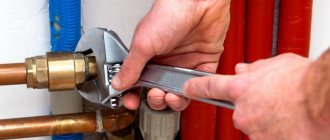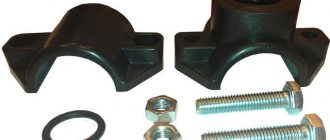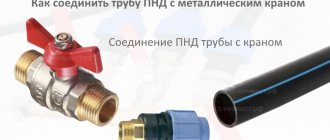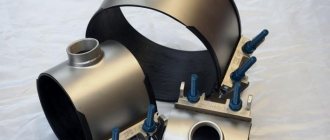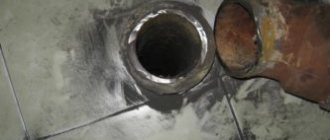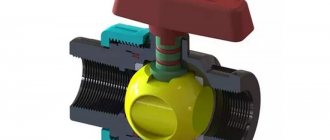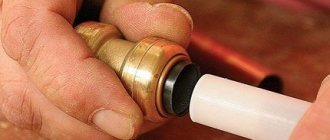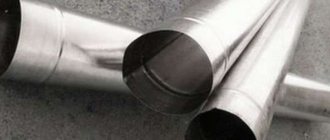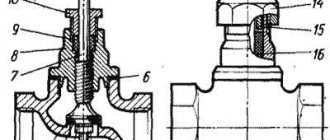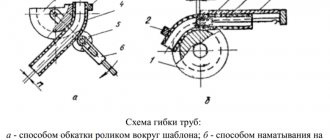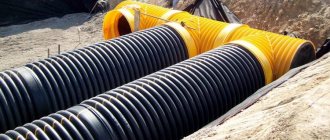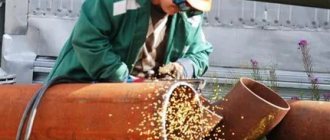Preparatory work
Before welding the pipe, it is necessary to prepare the metal in the joint area. The ends must be cut straight, otherwise it will be difficult to apply a reliable seam. The edges are chamfered so that the angle between them is 65 70˚. Surfaces at a distance of at least 3 cm from the ends are cleaned with a grinding machine or a metal brush until shiny inside and out. Areas that have changed color after treatment with a sander are removed. Burrs are removed with a file. The sharp edges of the edges are dulled to 2 mm, otherwise they will quickly melt. Then the surfaces are degreased with acetone.
The preparation of the electrodes is no less important. Before starting work, they are calcined in an oven at a temperature of 380-400˚C for two hours. For long-term storage, the electrodes are placed in a special case in which the temperature is maintained at 80˚C. A container for this purpose can be made independently from a polyurethane foam pipe. When long-term calcination is not possible, the electrodes are dried with a burner for one and a half minutes with a low flame. This method is prohibited by the rules, but in an emergency there is no choice. Since the coating of the electrodes dries quickly and picks up moisture again, you should not dry more than two pieces at the same time.
To read: Application of composite reinforcement in construction
Welding gas pipes under pressure
Welding special gas pipes for transporting high-pressure contents places increased demands on the process.
Gas pipe welding technology
Features of welding pipes for transporting high-pressure trains are determined by two characteristics:
- Thick walls and small diameter.
- Aggressive effects of transported gases.
Pipes up to 10 cm in diameter are welded manually, above - using semi- or automatic welding with manual welding of the root of the seam. For diameters greater than 6 cm, special rings are used. The weld is made multi-layered - from 4 layers and above, depending on the load on the pipeline and the characteristics of the material. After completing the work, a mandatory inspection is carried out - flaw detection inside and outside the welding site.
Yulia Petrichenko, expert
Video lesson on welding gas pipes
Pipe joining
To prevent the workpieces from moving relative to each other, the coils are laid on a corner or channel. Ideally, the discrepancy should be zero, since even a discrepancy of 1 mm, allowed by the rules, leads to lack of penetration. The gap, depending on the wall thickness, is set within 2–3 mm. In everyday practice, for this purpose an electrode of a suitable diameter is inserted between the ends of the pipes. For wall thicknesses of 10 mm or more, the gap is set to 3 mm. When joining, you also need to take into account the error that occurs during tack welding due to the heating of the metal at its points. The resulting thermal stresses tighten the pipes, so the gap is increased by a few tenths of a millimeter.
The docking process is simplified if you use a centralizer. It will ensure precise alignment of the pipe axes and constant position during welding. Usually an external centralizer is used, but it is better to choose an internal one, as it corrects irregularities in shape, for example, ovality of pipe ends.
Welding steel pipes “through transmission” - step-by-step instructions
Pipes with thick walls, in which 2 mm is only the amount of dullness, are welded “through the light”.
Preparation and cutting of edges
The abrasive method is the least reliable due to the introduction of abrasive particles into the metal, which interferes with high-quality melting and leads to the appearance of cracks.
- Use a double-sided Y-shaped symmetrical groove with an angle of 65 degrees, an optimal amount of bluntness and a gap of 2 mm.
- processing on a milling machine;
- manual bevel processing;
- cutting using abrasive wheels;
- processing with slotting-type edge cutters.
- Clean the joints of the welded products to white metal. There should be no irregularities, burrs or rust left.
- Treat surfaces with acetone or any similar substance. The presence of grease, dirt, and dust prevents the high-quality connection of metal molecules.
Centering and joining of pipes
- Centering and joining of small-diameter products is carried out by fixing them using improvised means or using assistants.
- Center large pipes (from 60 mm) with special equipment - a centralizer: internal or external. Both have an electro-hydraulic drive. Internal ones are more preferable due to the fact that when they are used, the joint remains uncovered. This allows the use of automatic welding machines, and also does not limit manipulations during manual connection.
- Do not allow deviations when using the manual alignment method. It is impossible to dock perfectly without a centralizer, but try to minimize the deviation.
- Having connected the pipes exactly, proceed to welding the root seam.
Root welding
- Cook the seam under the following conditions:
- minimum current;
- reverse polarity;
- short electric arc;
- dry electrodes;
- lack of wind in the pipe.
- Cook vertically, the electrode is perpendicular to the plane.
- Use an electrode to melt the edges - a bridge will appear between them, which is called a weld pool. In front of the jumper there is a so-called technological window.
- Carefully monitor the size of the technological window: throughout the entire process it should remain the same diameter.
- Make a root seam no more than 1 mm high. The return roller should also not exceed this value.>
- Clean the beginning and end of the seam and the transition area between the electrodes to avoid the formation of pores in the metal, the presence of which will sooner or later lead to loss of the pipe’s tightness.
Filling and capping of the weld
- After welding the root, fill the entire seam section.
- Depending on the wall thickness and material, use a single-layer or multi-layer penetration method.
- The movement of the electrode during filling is a triangle: edge 1 – edge 2 – technological window.
- Pay attention to the heating of the edges and root seam. The greater the heating, the wider the filling step.
- After each layer, clean the surface of slag.
- If you have the skill, and if the wall diameter allows, fill and cover in one pass.
Video lesson on welding pipes under clearance
Setting the welding machine mode
To weld a pipe under the clearance, it is recommended to use a DC welding machine. The work is carried out in direct polarity mode, when the electrode is connected to the plus and the pipe to the minus. The amount of welding current is set depending on the thickness of the pipe walls and the diameter of the electrodes. Its exact value in each case is selected experimentally. However, regardless of the size of the pipes, the creation of the root of the weld is carried out using electrodes with a diameter of 2.5 mm at the lowest possible current. Attempts to use the troika to speed up the process end in failure.
Selecting mode parameters
The welding current is selected: for single-pass welding - depending on the thickness of the pipe wall, and for multi-pass welding - based on the height of the bead, which should be 2 - 2.5 mm. Welding current is prescribed at the rate of 30 - 35 A per 1 mm of electrode diameter.
The arc voltage should be minimal, which corresponds to short arc welding.
The welding speed is adjusted as follows. to ensure the penetration of the edges and the formation of the required dimensions of the seam.
The consumption of shielding gas depends on the grade of steel being welded and the current mode (from 8 to 14 l/min).
Filler wire with a diameter of 1.6-2 mm is selected according to the grade of steel being welded (see article Welding materials).
Approximate modes
Diameter of W-electrode, mm
Additive diameter, mm
Welding current, A
Arc voltage, V
Gas consumption, l/min
Minimum current modes depending on the brand of W-electrode
Diameter of W-electrode, mm
Direct current (A) polarity
Alternating current, A
Welding begins immediately after installing the tacks, which must be remelted when performing the first layer. In hard-to-reach places, the first root weld can be made without filler wire if the gap and edge mixing do not exceed 0.5 mm, and the blunting of the edges does not exceed 1 mm. The exception is the joints of pipes made of steels 10 and 20, which always need to be welded with an additive.
The order of applying layers when welding a fixed joint by one welder
The arc should be ignited and extinguished at the edge of the pipe or at an already applied seam at a distance of 20-25 mm from the end of the seam. The supply of argon is stopped 5-8 s after the arc breaks.
Welding of pipelines made of high-alloy, especially corrosion-resistant, steels is carried out with protection of the weld root either by supplying argon inside the pipe, or using FP8-2 flux paste.
When welding high-alloy steels, a number of conditions must be observed:
- minimum current modes;
- short welding arc;
- maximum welding speed without interruptions and reheating of the same section of metal;
- avoid lateral vibrations of the burner;
- the filler wire should be fed evenly so as not to create splashes of molten metal, which, once on the base metal, can subsequently cause corrosion.
On thick-walled (more than 10 mm) pipelines with a diameter of more than 100 mm made of low-carbon and low-alloy steels, the root seam is welded using the argon arc method without remaining backing rings.
Welding should be carried out in a reverse-step manner in sections no longer than 200 mm. The height of the root seam must be at least 3 mm. In this case, it is necessary to ensure smooth transitions to the surface of the pipe.
Direction and sequence of laying the root layer
Argon arc welding is also used when welding the backing ring in pipes made of carbon and low-alloy steels. The ring is installed tightly, but without tension, in the pipe, leaving a gap between the ring and the inner surface of the pipe of no more than 1 mm. The ring is secured from the outside with a fillet weld 15-20 mm long with a leg of 2.5-3 mm to pipes with a diameter of up to 200 mm in two places, and with a larger diameter in three or four places.
Tack welding, regardless of the steel grade of the pipe and backing ring, is performed with Sv-08G2S filler wire with a diameter of 1.6-2 mm. The backing ring is welded with a single-layer fillet weld with a leg of 3-4 mm with the same additive.
Tacking and welding of the backing ring is done without preheating, regardless of the steel grade and pipe wall thickness. The exception is pipes made of steel 15Х1М1Ф with a wall thickness of more than 10 mm - the end of such a pipe is heated to 250 - 300 ° C.
There are few real specialists in electric arc welding of steel pipes. This work requires meticulous precision and a lot of practice. Welding the root seam is the most critical stage of the process.
Professional pipe welding
- Welding machine for polypropylene plastic pipes: how to choose a tool, equipment, video, reviews
- Welding polypropylene pipes: video instructions, heating temperature and time, soldering technology, how to weld plastic fittings correctly
The highest quality connection of steel pipes of any size is provided by electric arc welding. The parts being connected melt under the influence of an electric discharge. The article contains visual lessons on welding.
Welding process
Tack
Welding of the pipe under the clearance begins with tack welding at several points. Their number depends on the diameter of the workpieces, but not less than four in increments of 90˚. After creating the first point, the position of the pipes is adjusted if necessary. The tack should securely fasten the workpieces together. After welding all the points, the joint is cleaned again. Detected pores and poorly cooked areas are removed, as they will later become the cause of defects.
To read: Rules for selecting and operating a metal laser engraver
Root of seam
It is more convenient to carry out welding if the stuck pipes are in a semi-ceiling position. This will provide free access to the joint. A mark is placed on the bottom of the connection. Having retreated 1-3 cm from it, begin welding the root of the seam under the gap. The arc is struck at the bevel or its outer edge, but not at the surface of the pipe. On the ceiling part of the joint, the tip of the electrode is in the gap with a gradual upward movement. To form a return roller, the arc must burn inside the pipe.
When moving the electrode without lateral deviations, you need to ensure that both edges are melted. If only one side melts, you should stop and repeat the pass. An arc burning from the outside means that the joint has tightened. It can be cut through with a large current, but it is preferable to carefully expand it with a grinder. If the welded root weld sags, it means that the welding current is too high or the electrode is moving slowly.
If you imagine the end of the pipe in the form of a watch dial, then when leaving for 40 minutes the electrode begins to swing half the diameter between the edges. As a result, a technological window is formed through which the formation of the inner roller can be monitored. When welding thin-walled pipes of small diameter, it is only outlined, but you should not melt a through hole at this place. The electrode moves without oscillating movements, only the position of the holder changes to ensure arc stability at a minimum current.
Technology of electric arc welding of metal pipes
Electric arc welding has technological standards and specific features depending on the material, wall thickness and intended purpose of the pipes.
Welding of fixed pipe joints
The connection of fixed joints is carried out in three ways, which depend on the location:
- vertically;
- horizontally;
- at an angle of 45 degrees.
The vertical method includes 4 stages:
- Welding a pipe to create a root bead. The most important stage is the formation of the joint, which will be the basis for all work. The inclination of the electrode relative to the surface: “backward angle.” The length of the arc should be adjusted: if the penetration is insufficient, set it to short; if it is normal, set it to medium. Keeping the weld bead in a liquid state for a long time leads to the occurrence of defects. Therefore, with a large volume of the weld pool, the welding speed is reduced.
- Welding three beads and sealing. The rollers are performed at high speed. Depending on the direction of the slag, rectangular or “backward angle” welding is used. The top edge of the last roller must have a minimum value up to the top edge. Usually equal to the diameter of the electrode.
- Forming a lock at the beginning and end of the rollers. The formed lock is the beginning of the roller with a 5 mm offset from the previous one. When making a joint, the roller must be continuous along its entire length.
- Welding on the front side. It is performed at high speed and aims to form a flat surface. Welding ends when it goes beyond the beginning of the seam.
The horizontal method requires professional skills. It is produced at different welding current values and at different angles to the part. This technique involves three stages:
Within one stage, welding takes place continuously, starting from the “backward angle” position and ending with the “forward angle” position.
Welding at a pipe angle of 45 degrees begins with creating the first bead at an electrode angle of 90 degrees. The seam is made by continuously melting the second roller. After filling the base, the first roller is melted. This creates connections horizontally and vertically.
Welding pipes “under clearance”
The technology provides the following conditions:
Read also: Capacitor for a washing machine motor
- dullness size: 2-2.5 mm;
- gap between edges: no more than 3 mm;
- opening angle: in the range from 60 to 70 degrees;
- additional processing of edges by chamfering to give them the required shape and eliminate irregularities;
- the difference in the thickness of the welded walls should not exceed 3 mm or 10%.
Welding of high pressure pipelines
A feature of welding high-pressure pipelines is the need for preheating of the joined elements to 300 degrees C, which is maintained throughout the entire tack and welding process.
When cooking gas pipelines, take into account:
- That thick-walled pipes are used for gas mains, which increases the overall labor intensity of the work.
- There are increased demands on the quality and reliability of the weld, so professionals with extensive experience are involved in the work.
- The entire system as a whole (pipe, as well as joints, welds) must be resistant to corrosion. After the end of cooking, to relieve thermal stress, a section of 10 cm in each direction from the seam is heated to 500-600 degrees C. For this, thermal ovens, induction heaters, and gas burners are used.
When heated, the ends of the pipes are closed to prevent cooling and air movement in the pipe.
Automatic welding
The so-called submerged arc welding involves feeding an electrode wire into the combustion zone of an electric arc using an automatic welding head. In the molten state, the wire metal enters the weld pool and mixes with the base metal.
Automatic welding allows:
- speed up and stabilize the process;
- make the arc invisible;
- expand the range of parts in thickness;
- make the seams more resistant to the formation of cracks and pores.
Flux has a positive effect on the stability of the arc and the chemical composition of the weld. To carry out automatic welding, the ability to rotate the joint is necessary.
Welding large diameter pipes
In more than half of the cases, the connection of steel main pipelines is carried out using pipe welding machines. When it is impossible to use the mechanical method, for example, due to localization features or limitations in manipulating the pipe, manual welding is used, carried out by a team of welders.
For main pipes with a wall less than 6 mm, two layers of welding seam are used, and more than 6 mm - three. The reverse roller of the root seam can have a height of up to 3 mm. In those places of the root weld that are welded poorly, additional welding is carried out from the inside of the pipe. This requirement also applies to that part of the root that was made in the ceiling position: the lower quarter of the joint perimeter is welded from the inside. Rotary joints require welding along the entire perimeter of the joint. Welding is carried out with 3-4 mm electrodes.
Large diameter pipes require the use of special centering equipment.
